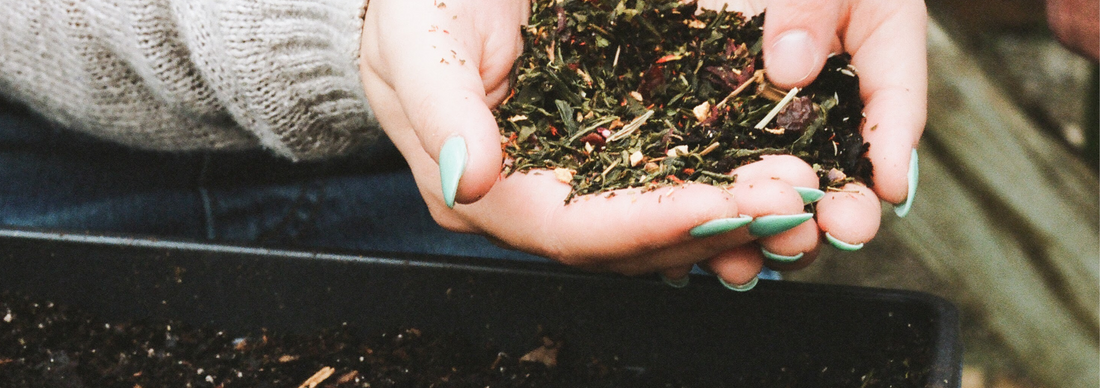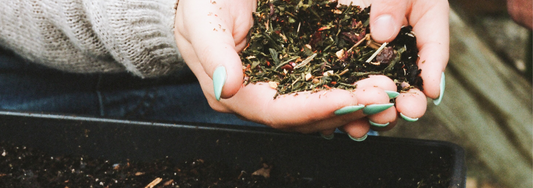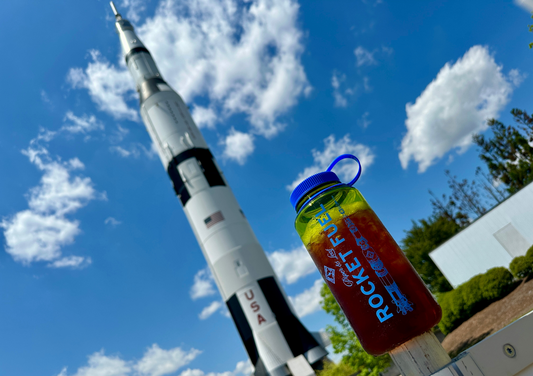
Today we are going to go back to our roots a bit and talk about tea compost. For those of you who may not know, Piper and Leaf started out at our very first market selling compost tea! Which, while a great idea, did not turn out quite as we expected, being that we aren’t quite in the business of selling compost! Regardless, you can use what we are in the business of selling to make tea compost. Curious how we went from selling compost to artisan, handcrafted tea? Read here to check it out!
What is Compost Tea?
Compost tea is water in which compost has been steeped, just like a tea bag in water! Leached into that liquid are some of the compost's nutrients, microorganisms, and a brew of compounds called humates. Humates help plants use nutrients in the soil better and offer many other benefits.
In a way, how you absorb all the vitamins and nutrients from each of our amazing blends is the same thing that happens with compost tea for plants!
How to Make Compost
Now, some of you may wonder what compost is. You know when you cook dinner, peel all your fruits and vegetables, and you end up with a pile of scraps? Compost is all your fruit and veggie scraps, and even the fruits and veggies you forgot you had in the fridge till it was a little (or a lot) too late, broken down to use for plant food! But composting doesn’t stop at fruits and vegetables, you can also compost eggshells, rice, grains, flowers, coffee grounds, cooked food without oil, dairy, or meat, paper, cardboard, sawdust, nail clippings, hair, and best of all, tea bags!
Fun Fact: Did you know that we bag our tea with all-natural, non-GMO Sugar Cane material, i.e. no microplastics! Because of this, our tea bags are not only high quality, but are ideal for tossing into your compost pile after enjoying a cup (or two), of course!

It is easy to say “just toss your tea bags into your compost bin,” however, it proves to be a challenge if you don’t have compost to toss them into! Our journey to sustainability has been an integral part of our business since day one. Not only that, but so have you. Our goal is to not only share lots of fun memories and delicious tea, but to come alongside you, as you have done with us, and share our knowledge and experience to best help one another. All of that to say, grab your shovel and that set of clothes designated for getting dirty, and get ready to make some compost!
The Process
For some of you, you may be ready to dive in with reckless abandon, eager to tackle whatever lies ahead. While others... maybe not so much. Don’t worry, we have all been beginners at something! Even after being in business for 10 (almost 11) years, we still learn something new every day. So, to all our green thumbs or aspiring ones, fret not. You’ve got this!
First, you want to ensure you have all the materials to set yourself up for success! Grab a large bin of any kind, a pitchfork, and any leftover fruit and veggie scraps or organic material, and you are ready to get started!
The first step is to create or buy a bin to hold your compost. Compost bins come in many shapes and forms. From luxury bins designed for compost to a waste pile in the back yard blocked in by a few boards, as long as you have space to move your compost around, you can start composting! Note: If you decide to have a large compost pile in your backyard, a good rule of thumb is to keep it around 3 feet high. This ensures your compost will be easy to move around and keep it compact!
Next, you want to choose a space for your compost bin! While the process of making compost is fascinating, it is always good to keep in mind that compost is waste breaking down, which is prone to being a tad on the smelly side. So, when choosing a space to start your compost, be sure it is an area where the smells and gases have room to escape and enough air to keep your compost aerated.
Now comes the fun part! Just toss in any biodegradable material you have around and let the magic happen. When tossing in any dry materials like leaves, hay, or paper, douse it with water to help keep your compost moist and the decomposition process active! You will want to use a pitch fork to move your compost around every couple of days to keep everything nice and active.

As nice as it would be to toss in your scraps, walk away, and come back to beautiful, rich compost, with all good things, they take time and intentional care. Compost needs to be checked regularly to ensure it is on the right track to properly breaking down all the organic materials. When you check your compost, it should be warm, between 141 and 155 degrees. Warm compost is a sign that it is alive and actively breaking down waste. You can check the temperature of your compost with a thermometer or your hands, whatever is best for you! If you notice your compost is not warm, make sure it is damp and give it a toss to get things back in action!
Remember when I said good things take time? As you can imagine, composting materials is not a quick process. Developing good compost can take months or even years before it is ready. The best thing you can do to help speed up the process is maintaining the moisture content in your compost by covering it with a tarp! You will know when your compost is ready to use when the bottom layer is dark and rich in color!
Making Compost Tea
Once you have a fair amount of compost, you can make your plants a drink to help them thrive even more than they are or give them an extra boost if they need it!
If you thought making compost was easy, then making compost tea will be a walk in the park! Just grab a 5 gallon bucket, a shovel scoop worth of compost, and non-chlorinated water!
In the bottom of the five gallon bucket, toss in your compost, then fill it up the rest of the way with water! Stir vigorously, then set aside for one week, stirring once or twice every day. After one week, strain the compost from the water. Once strained, your compost tea is ready to use! If your tea seems extremely dark or if you plan to use it for a large area, dilute using a 1:1 ratio. Simply spray it on the plants leaves or in the soil by the roots and watch your plants thrive!
Tea and Sustainability

Though we started out selling compost, it didn’t take us long to figure out that our path was heading down a much different route. While we no longer sell compost, as avid supporters of local farmers, we understand the importance of compost to the lawn care and agricultural industry. We at Piper and Leaf have been navigating our sustainability journey since day one, and we continue that journey each day with each jar and one compostable tea bag at a time.



